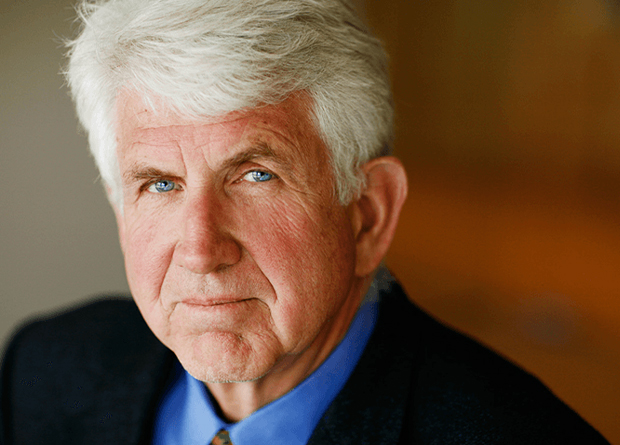Ethernet is such a ubiquitous and familiar part of the connectivity universe that most of us take its existence for granted. When we are planning to connect PCs, printers and other devices in a local area, we don’t consider any alternative. For communications service providers looking for dependable wide area plumbing, there’s really no better choice than its carrier-grade derivative.
Amazingly, Ethernet is now 40 years old as a commercial standard. To celebrate this incredible landmark, NetEvents offered the world a chance to hear directly from Ethernet’s creator, Bob Metcalfe.
Exactly four decades to the day from the publication of the first Ethernet specification, Metcalfe was interviewed by Jensen Huang, Founder and CEO of accelerated-computing giant NVIDIA. This one-off event was followed by a live panel discussion involving the principals from a range of leading Ethernet industry organizations.
Huang asked Metcalfe to recall the early days of Ethernet, a world where there was no single standard for linking devices over a local area, when it was a matter of choosing one of many possibilities, and offices were usually a messy combination of several of these.
Metcalfe noted that Ethernet’s origins in fact date back further than 1980. Working for Xerox’s Palo Alto Research Center (PARC) in the early 1970s, he thought there had to be a better way of doing things. He explained to the organisation’s management that he should be allowed to install one simple type of network throughout the campus, and the result was a coherent system that moved data around at three megabits per second – impressive for the time.
After several years as Xerox’s in-house networking standard, it was time for Ethernet to begin its journey as a universal standard outside PARC’s walls. Metcalfe decided it was the moment to leave the company and commercialise his invention, and in September 1980, he did just that.
He takes up the story: “I left Xerox in January of 1979 with the intent of starting a company. I had a meeting in February of that year with Gordon Bell, who was then the Vice President of R&D of Digital Equipment Corporation (DEC), the number two computer company in the world after IBM. Gordon asked me to design an Ethernet for DEC. I said I couldn’t do that because firstly I felt loyal to Xerox, and secondly, I’d already designed the best network I knew how and DEC’s would be second best. So together we wrote a letter to Xerox proposing that DEC and Xerox would work together to get their products to be compatible over Ethernet. Then I ran into Intel Corporation down at the National Bureau of Standards looking for a new chip standard to implement. So pretty soon we had DEC, Intel and Xerox co-operating on connecting with Ethernet.”
Ethernet was not an instant hit. The world of technology is often fragmentary, proprietary and partisan. A new standard invariably has work to do to overcome people’s prejudices and their allegiance to something else – even if that something else is demonstrably inferior. Rivals, like Token Bus and IBM’s popular Token Ring, meant Ethernet had its early work cut out. But it has its important early backers. And the virtues of its openness soon became a talking point in a world where IBM Token Ring, on the face of it an open standard as well, pretty much committed you in reality to investing in the whole IBM shooting match.
“There was 802.3, which was Ethernet,” recalls Metcalfe. “Then 802.4 was Token Bus, and 802.5 was IBM Token Ring. And the way we proceeded from there was in fierce competition for the next 20 years.”
Ethernet’s strength, and the secret to its longevity, lies not just in its open and agnostic nature but in the way it continually evolves to meet new generations of connectivity needs. That has taken it through many important cycles and past many landmarks on its journey. For example:
- In 1995 100 Mbps Ethernet, or Fast Ethernet, was born, in a large measure spelling the end of Token Ring. This was not only a jump in performance but also interoperability since it allowed two devices on the network to establish the best shared mode of operation
- In 1999, Gigabit Ethernet, or 1000Base-T, was launched operating at much faster speeds than Fast Ethernet and heralding the emergence of Ethernet as a true enterprise-class connectivity standard
- Speeds of 10 Gbps became possible in 2002, enhancing Ethernet’s popularity for seriously high-performance tasks
- By the end of that decade, the IEEE had approved 40 GbE and then 100 GbE speeds became possible by aggregating 10 Mbps lanes
- In 2016 and in the face of demand from a new generation of users in the form of hyperscale web giants, the IEEE debuted 25 GbE, making Ethernet more cost effective than ever
- In 2017, Ethernet networking moved on to 200 GbE and 400 GbE in response to cloud-driven demands for faster and faster speeds and higher bandwidth. Now Ethernet is looking at 800 Gbps, 1 Tbps and beyond
But the beginning of this journey was something of a leap of faith: “One of the principles of Ethernet was ‘build it and they will come’,” as Metcalfe puts it. “That is when we built that first Ethernet to run a 2.94 megabits per second, we did not have a requirements document from anybody saying they needed 2.94 megabits per second. We just built it as fast as the semiconductors would allow. And that’s been a principle of Ethernet. They’re building an 800 gigabit per second Ethernet right now. I’m certain there is no one requiring it today.”
Huang reminded Metcalfe that one of Ethernet’s strengths was that the standard was sufficiently high level that it could be a foundation, but not so high level that innovation on top couldn’t happen. “And so the Internet was built on top of it,” Huang pointed out: “And because the Internet was built on top of it, it’s a platform which all kinds of applications are built on top of. The brilliance of Ethernet to me is that it’s the ultimate platform strategy, the ultimate platform innovation, sufficiently specified but also sufficiently open ended. That fine balance is what makes this rich ecosystem possible and I think it’s completely genius.”
Metcalfe and Huang look forward to Ethernet’s next challenges, with Metcalfe noting that there are 7.7 billion humans on the internet, but eight billion things on the internet already: “This is before you begin talking about bringing in AI for edge computing,” he says.
“I think the Internet is going to be thousands of times bigger than it is today,” agrees Huang. “The amount of traffic that’s going to go through it is going to be just phenomenal.”
Paying homage to Ethernet as the basis for all this future growth, Huang concludes: “This is all built on top of your incredible invention. And so I, on behalf of all of the engineers and computer scientists in the world that participate in this industry, acknowledge that Ethernet has made it possible for us to enjoy an industry far greater than any of us could have possibly imagined in the early 90s.”
He points out that Metcalfe’s CV includes being a recipient of awards such as the National Medal of Technology, the IEEE Medal of Honour, the Internet Hall of Fame, the Alexander Graham Bell medal, the Grace Murray Hopper award, the Computer Science Award.
The interview was followed by a panel discussion and media Q&A led by Tam Dell’Oro, Founder and CEO, Dell’Oro Group with Bob Metcalfe and the heads of major industry associations including: Brad Booth, Chair, Ethernet Technology Consortium; David Law, Chair, IEEE 802.3 Ethernet Working Group and Nan Chen, President, MEF.









































































































